Covid risk higher for disabled  People who received disability support services in 2022 were 13 times as likely to die from Covid-19 than the general population, new data shows. Manatū Ora – Ministry of Health has released a report about the burden of Covid-19 in the disabled population who receive Disability Support Services (DSS). It analysed data from 43.000 people who received DSS between 1 January to 16 November 2022. The data showed that while those on disability support were around 9% less likely to contract Covid-19 they were 4.2 times more likely to be hospitalised because of Covid and 15 times as likely to die from the virus compared to the general population. New Zealand Disability Support Network chief executive officer Peter Reynolds said the report highlighted disabled people’s heightened vulnerability to Covid-19, and the need for better data on their health. “While the data is limited to only a subsection of disabled people, it shows the importance of the steps taken by disability providers, in conjunction with government agencies to protect disabled people from exposure to Covid-19,” he said. “Disabled people frequently have medical conditions that make them more at risk from Covid-19, but this can be mitigated against by vaccinations, PPE and other protective measures.” Reynolds said the Government needed to continue to support the efforts of disability providers to reduce the chances of disabled people catching Covid-19. But he said the analysis that serious limitations and the true impact of Covid-19 on the disability community was still not known. “The fact that disability status is not lined to people’s National Health Index number meant that data for 97% of disabled people could not be analysed,” he said. Only Covid data for the relatively small proportion of people who receive Disability Support Services was available. This shows the need for better joined up data collection.” Ref: Ripu Bhatia, The Press 11/3/23 Seniors and Skin Health 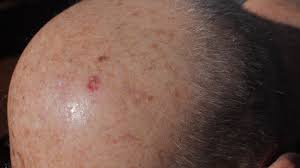 It’s very important that the elderly take care of their skin because they are more susceptible to skin infection and skin disease due to the changes that take place to skin as we age. It becomes less supple, thinner and dryer. It injures easier and heals more slowly. As a result, seniores are prone to skin problems ranging from itching, scaling and mild dryness to grave skin conditions such as infection and ulcerations. A severe skin infection or non-healing wound in the elderly can be very serious, even fatal. Common skin conditions of the elderly: Senile Purpura – are the purplish sports that appear most often on the arms and legs due to thinness of the elder person’s skin and frailty of the capillaries and blood vessels just below the surface. Stasis Dermatitis – is more common in elderly women than men; it is characterized by dry, itchy skin. Exfoliative Dermatitis – is more severe form of dermatitis than stasis dermatitis and is characterized by excessive peeling and shedding of skin. It is of particular concern in the elderly because the severe itching can lead to infections. 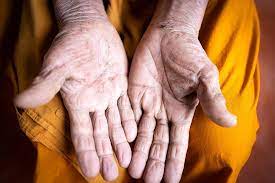 Skin infections/Infestations – bacterial infections and parasitic infestation such as scabies or ringworm are common in the elderly. Cancerous and noncancerous skin growths. Viral skin disorders – such as shingles and herpes zoster. In general, the elderly have special skin care needs because aging skin is so thin and dry. If it becomes too dry, it is prone to cracking and dermatitis, which allows for penetration of bacteria that can result in infection. The elderly should:
 To promote good skin health, seniors should also:
(Aged Care New Zealand, Issue 01 2022, pg. 83) Skin tears in older people 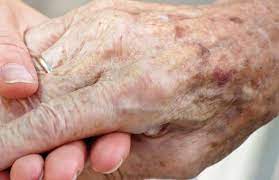 A skin tear is an injury that causes the skin to peel back or can result in total skin loss. Older people and new-born babies are at the highest risk. In most people they can cause minor wounds and often bruising, however, they can cause more serious wounds issues. Skin tears mostly occur on the legs, arms, and the back of the hands. Skin tears can become chronic wounds if neglected or treated poorly, damaging the individual’s health and generating significant healthcare costs. Given the ageing of the New Zealand population, skin tears will inevitably increase as a public health problem, so their prevention and management is important. A skin tear is an injury that causes the skin to peel back or can result in total skin loss. Older people and new-born babies are at the highest risk. In most people they can cause minor wounds and often bruising, however, they can cause more serious wounds issues. Skin tears mostly occur on the legs, arms, and the back of the hands. Skin tears can become chronic wounds if neglected or treated poorly, damaging the individual’s health and generating significant healthcare costs. Given the ageing of the New Zealand population, skin tears will inevitably increase as a public health problem, so their prevention and management is important. 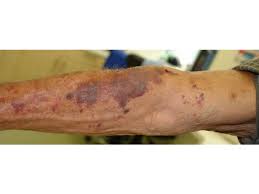 Definition of skin tears Skin tears are lacerations that can extend through the epidermis (the top layer of skin) and into – but not through – the dermis, which is the lower layer of skin that contains capillaries, nerve endings, sweat glands and hair follicles. Friction or shear force can cause separation of the epidermis from the dermis, thereby creating a jagged or angular flap of skin. The epidemiology of skin tears Research has found that skin tears account for nearly 55 per cent of all wounds in the elderly. A recent systematic review found incidence rates of skin tears in the elderly, ranging from 2.2 per cent to 92 per cent per annum in long-term residential care facilities and 2.1 per cent among men to 4.6 per cent among women living in the community. A study performed in six long-term care facilities found skin tears in nine per cent of residents. The effects of decreasing hormonal levels on the skin make women more susceptible to skin tears than men. Women’s longer life expectancies exacerbate their higher incidence of skin tears. Causes and risk factors The risk of sustaining skin tear increases significantly as the skin becomes weaker, drier, less elastic, and thinner due to decreased subcutaneous fat, collagen, elastin deposition and sebum gland secretion that comes with ageing. 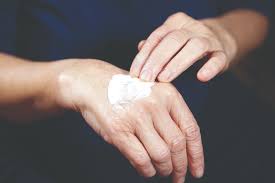 Japanese research found that photo-ageing, specifically sun damage to the dermis as a result of outdoor lifestyles and occupations, was a risk factor for skin tears. Other risk factors for skin tears:
Research has documented associations between skin tears and age-related factors such as dependency in activities of daily living, sensory loss, limited mobility, use of assistive devices, impaired cognition and medication. Poor nutrition can increase risk by further weakening the skin and reducing its shock-absorbing capacity. A review of nine studies found that the most common characteristics of patients with skin tears were a history of skin tears, impaired mobility and impaired cognition. Healthcare practitioners can also inadvertently cause skin tears when handling elderly patients or removing adhesive bandages and tapes. They can also be inflicted during routine activities such as dressing and bathing, falls, bumping into objects, patient transfers and using wheelchair and other mobility aids. People living with dementia and other mental health conditions can behave in an agitated manner that can increase the risk of skin tears. Prevention The most common-sense recommendations for the prevention of skin tears in the elderly include:
Researchers tested the effectiveness of a twice-daily moisturising regime, compared to ‘usual’ skin care, for reducing the incidence of skin tears in the residents of 14 aged-care over six months. The intervention group received twice-daily application of a commercially moisturizer or their forearms, lower legs, hands and feet; the control group received no standardized skin-moisturising regimen. The intervention group recorded an average of 5.76 skin tears per 1000 occupied bed-days, versus 10.57 in the control group – an almost 50 per cent reduction in incidence. Other ways to look after the skin:
Treatment The first response to a skin tear is to clean the wound with saline solution or warm water and gently pat it dry. If a viable skin flap exists, it should be replaced over the dermis, using forceps or a moist cotton bud before a dressing is applied. New technologies have led to the development of highly effective bandages that create a seal to prevent bacteria and water from aggravating the skin tear. In addition, zinc applied in a paste or bandage has been found to offer protective, anti-inflammatory and antibacterial properties, which promote healing by stimulating cell growth. If any of the following occur, seek medical attention:
(Aged Care New Zealand, Issued 01 2022, pg. 90/91) 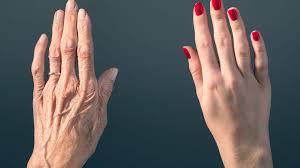 Maintaining skin health in older people Age related changes in the skin mean older people are of increased risk of skin breakdown, and should be supported to maintain good skin health. This article examines general skincare for older people, skin barrier function and the skin changes associated with the ageing process. Skin assessment and the use of washing products and emollients are discussed and methods by which older people and nursing staff can help to promote and improve skin health are identified. As the skin ages it becomes less able to perform its key barrier functions and skin breakdown becomes an increasing risk. This can have a detrimental impact on quality of life with major economic implications (Gardiner, et al 2008), so skin health is essential to the wellbeing of older people and a central component of nursing care. It is estimated that approximately 70 per cent of older people in Australia experience skin problems, many of which are preventable. Structure and function of the skin The skin is the largest organ of the body, covering approximately two square metres (Penzer and Ersser, 2010). It performs a number of functions including:
The skin has two main layers: the epidermis (outer layer) and the dermis. These provide supportive structures allowing the epidermis to function. The stratum corneum provides the skin barrier. In normal skin it is resilient, protecting the underlying skin from the penetration of irritants and allergens and preventing the loss of wafer from the body. The corneocytes are full of water; this results in a smooth barrier with no cracking between the corneocytes, which also contain high levels of natural moisturising factor (NMF) -a humectant. Normal skin is smooth and elastic and does not itch (Cork and Danby, 2009). The natural pH of the skin is slightly acidic – between 4 and 5.5 – providing protection from microbes (Cowdell, 2010). Damage to the skin barrier allows for water to be lost and irritants and allergens to be introduced, leading to inflammation (Cork et al, 2006).  Skin ageing As we age the skin is affected both by intrinsic and extrinsic factors. Intrinsic ageing is the ‘programmed’ true biological changes (Lawton, 2007). Extrinsic factors, such as damage from exposure to the environment (Lawton, 2007) and the sun (ultraviolet exposure) also affect skin ageing. Other extrinsic factors include smoking, environmental pollutants (Lawton, 2007), reduced peripheral sensation, reduced mobility, incontinence, depression and dementia, polypharmacy, diabetes and vascular changes and poor nutrition (Finch, 2003). Although ageing cannot be prevented, strategies to enhance skin-barrier function can be used and the risk associated with extrinsic factors can be reduced. It is estimated than at least 70 per cent of older people will have a skin problem (APGS, 2000) and skin conditions are on the most common reasons for primary care consultations (Schofield et al, 2011). Davies (2008) identified skin conditions that commonly affect older people (Kirkup, 2006) possibly because they see skin deterioration as an inevitable part of ageing and believe no help is available. Fanos and Laird (2001) also noted that clinicians may see concerns as trivial. It is therefore important that nurses routinely enquire about skin heath in older people and undertake accurate and thorough skin assessment to identify problems (Nazarko, 2009). Assessment is not a one-off activity but an ongoing process, involving monitoring change and response to treatment. It should include:
Finch (2003) gave a detailed explanation of skin assessment. If any skin problems are identified on general assessment, further assessment, investigation, and completion of risk assessment tools should be undertaken as required. Skin Care Skin care is one of the cornerstones of nursing practice, but the importance of general skin care is an area of practice that is often overlooked (Castledine, 2003). However, maintaining or improving skin health is generally neither costly nor difficult. Simple, low-cost interventions can have a positive impact on quality of life and help to prevent skin breakdown. Skin hygiene is essential for skin health and important in promoting personal wellbeing. For older people with dry skin, it is particularly important to achieve a balance between cleanliness and over washing, which may damage the barrier function (Voegell, 2008a). Use of appropriate washing products and emollients can contribute to maintaining skin health. Washing products Washing with soap and water remains the standard method of skin cleansing (Ersser et al, 2005) and is recommended in many nursing texts (for example, Downey and Lloyd, 2008; Dougherty and Lister, 2008). However this can cause an increase in skin pH (Korting et al, 1987), which can alter the skin’s normal bacterial flora, increasing the like hood of colonisation with more pathogenic organisms (Cooper and Gray, 2001). The increase in pH can also damage the skin barrier and cause irritation (Kirsner and Froelich, 1998). Soap also removes lipids from the surface of the skin and over washing removes NMF (Pe ters, 2001), resulting in further skin dryness. If acceptable to the individual, using emollient and soap-substitute products rather than soap will help to maintain skin health. Emollients Emollients increase the amount of water held in the stratum corneum, either by occlusion (trapping the water in and preventing evaporation), or by actively drawing water into the stratum corneum from the dermis (Ersser et al, 2009). They play a crucial but often undervalued role in skin health and are the mainstay of therapeutic treatment for older patients with dry and itchy skin. Although their benefits are widely acknowledged in the field of dermatology, they have tended to be undervalued and underused in general care (Lawton, 2010). Adverse effects from emollients are rare, although occasionally sensitisation to an ingredient may occur. There are many formulations of topical emollients including ointments, creams, lotions, gels and sprays. Ointments are the greasiest preparations and often contain paraffin; creams are an emulsion of oil and water; lotions are the least greasy, making them less effective as an emollient. Cosmetic acceptability is, however, an important consideration. Some products contain humectants such as urea or lipids (NMF), which provide excellent moisturisation (Lawton, 2010). Emollients alone may be sufficient to alleviate skin dryness but can be considered as adjuvant therapy alongside other tropical or systemic treatments in chronic skin conditions such as eczema or psoriasis (Ersser et al, 2009). There is little scientific evidence on how to apply emollients, although it is generally agreed they should be applied using a gentle stroking motion following the lie of the hair on the body (Penzer and Ersser, 2010). This rationale is based on the principle that rubbing with a greasy emollient may lead to an irritated or blocked hair follicle and subsequent folliculitis. Ersser et al (2009) recommend application of emollients during the day at times convenient to the individual – this may be as frequently as every two to three hours, and at bedtime. A greasier emollient may be acceptable for use overnight, so it is important that an adequate supply and several preparations are available. 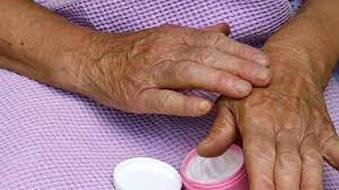 Self-care Self-care and self-management are central to Australian health policies and undoubtedly the majority or older people would prefer to meet their own skin-care needs as far as they are able. Nurses should facilitate self-care wherever possible to ensure effective skin care and minimise deterioration in condition (Burr, 2007). Many older people can care for their own skin provided they have sufficient knowledge, skills and confidence to do this (Bandura, 1997). They may face difficulties such as reduced mobility and dexterity, cognitive impairment, increased frailty and difficult social circumstances but these can often be minimised or overcome if the multidisciplinary team is involved, and they are advised on different techniques or enabled to use appropriate aids. Conclusion Skin health is essential to the wellbeing of older people and a fundamental aspect of nursing care. Nurses should regularly assess the skin health of older patients, promote self-care and encourage the use of appropriate products. Authors: Fiona Cowdell, senior research fellow and graduate research director at the Faculty of Health and Social Care, University of Hull; Kathy Radley is a lecturer in skin health and dermatology care at the Faculty of Health and Social Care, University of Hull, and clinical nurse specialist, dermatology at United Lincolnshire Hospital Trust. (Aged Care New Zealand, Issue 01 2022, pg. 82/83) |
AuthorShonagh O'Hagan Archives
July 2024
|

 RSS Feed
RSS Feed